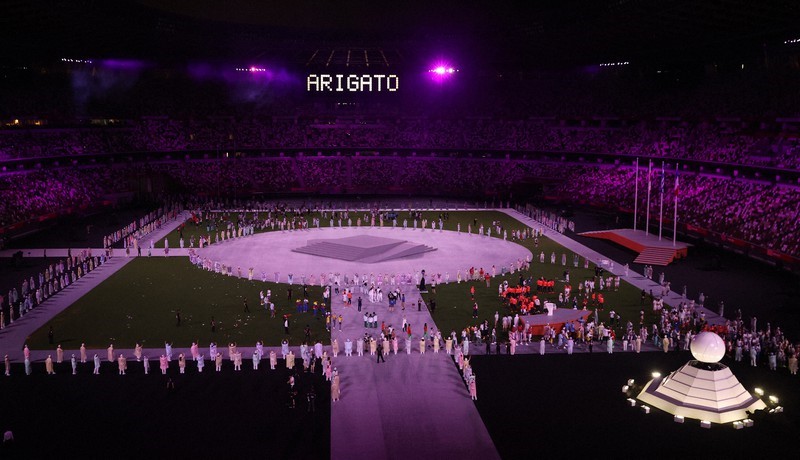Bach's walk around Tokyo symbolizes Olympics' shameless 'IOC-first' mentality

TOKYO August 13, -- The recent actions of International Olympic Committee (IOC) President Thomas Bach made a Mainichi Shimbun reporter want to ask himself if the Tokyo Olympics were held solely for the benefit of the organizer, the IOC. During the Games, there were many occasions when priority appeared to be focused on the IOC.
Most notable was Bach's stroll in trendy Ginza in downtown Tokyo, on Aug. 9, the day after the closing ceremony. Wearing a polo shirt, he walked through the Ginza shopping district just after 4 p.m., with security guards at his side. The central government did not see this as a problem.
The athletes were under strict restrictions from rules in the "Playbook" outlining measures to prevent the spread of the coronavirus. When two members of the Georgia judo team went sightseeing at Tokyo Tower and other places, they were stripped of their accreditation.
On the other hand, Games-related officials are only required to limit the scope of their activities and not use public transportation for 14 days after entering Japan. Once that period is over, there are no restrictions on their activities. The government claimed that Bach, who arrived in Japan on July 8, is therefore not subject to the restrictions.
On July 26, during the early stages of the Games, Bach was in a good mood at the Nippon Budokan, the venue for the judo competition. He smiled and spoke to Hifumi Abe, who had won the gold medal the day before in the men's 66-kilogram category, and his sister, Uta Abe, who was in the women's 52-kg category. At the official guest seats, they watched together the men's 73-kg event, in which Shohei Ono won his second consecutive Olympic gold medal. Although they were wearing masks, they were close, within a meter of each other.
This reporter felt something was strange. Bach had visited many of the competition venues and was outside the so-called "bubble system." Even though the first 14 days after entering the country had passed, it was still risky to interact with athletes who were avoiding contact with the outside world at the athletes' village. In addition, at many venues without spectators, excluding the bicycle races in Shizuoka Prefecture, even athletes' families were not allowed to enter.
The families have naturally long supported the athletes. According to a source close to the Games, Seiko Hashimoto, president of the Tokyo Organising Committee of the Olympic and Paralympic Games, requested the IOC allow the Japanese athletes' families to watch the games, but it was turned down.
In the previous Olympics, the families of athletes were not given entrance permits as affiliates, but were allowed to enter with tickets prepared by the sports organizations and others. The IOC responded by citing the fact that tickets were no longer being issued due to the decision to have no spectators, and told them that if the organizing committee wanted to allow families in, they had to allow spectators in.
As an alternative, monitors allowing athletes to talk with their families online were set up in the mixed zone for reporters covering the event. This may have been a way to find a balance with the fact that the families of overseas athletes were not allowed to enter Japan.
Still, the actions of President Bach are incomprehensible. At the karate venue, he called out to Kiyou Shimizu of the women's kata division, who was being interviewed before the finals, forcing the interview to end as a result. When the press asked for clarification, a spokesperson for the organizing committee replied, "Regarding the interruption of Shimizu's interview at the karate venue, the details were unclear except that it was ordered by the International Sports Federations."
The closing ceremony on Aug. 8 was not an athlete-first event either. Its venue, the Japan National Stadium, was so humid from rain that fell until the early afternoon that participants' shirts became caked with sweat.
A highlight of the ceremony's second half was a scene where particles of light gathered and turned into the Olympic symbol. The images were computer graphics, and the Olympic symbol was projected on a large screen. But at the venue it looked like nothing more than particles of light. The IOC depends on broadcasting rights revenue. Although it was not involved in the staging of the ceremony, the show was symbolic of events produced with TV viewers in mind.
Overall, much of the program was video-based. According to the organizing committee, performer numbers were reduced to about a quarter of initial estimates due to reasons including cost-cutting and coronavirus measures. All of the traditional local dance performances from across Japan, such as the ancient dance of Hokkaido's indigenous Ainu people and the Ryukyu "eisa" originating in southernmost Okinawa Prefecture, were prerecorded. Because of this, enthusiasm on site was low, and we reporters felt almost like we were watching it on TV.
Regarding why there were so many videos on stage, an official at the event said, "This was not because of cost reductions due to the postponement of the Games. It was probably due to a series of resignations and dismissals of members of the opening and closing ceremonies, which forced them to change the staging."
At first, the athletes were enjoying taking pictures as they liked, but after about an hour, some of them sat down on the grass due to fatigue. The athletes, who were supposed to be the stars of the event, were mere bystanders. The closing ceremony should be a stage to honor the athletes by, for example, giving awards to those who did not win medals but left lasting impressions with their memorable performances.
"Dear athletes, over the last 16 days, you amazed us with your sporting achievements," said Bach as he opened his address. Ironically, the athletes turned away one after another and left the venue. (Mainichi Japan)



